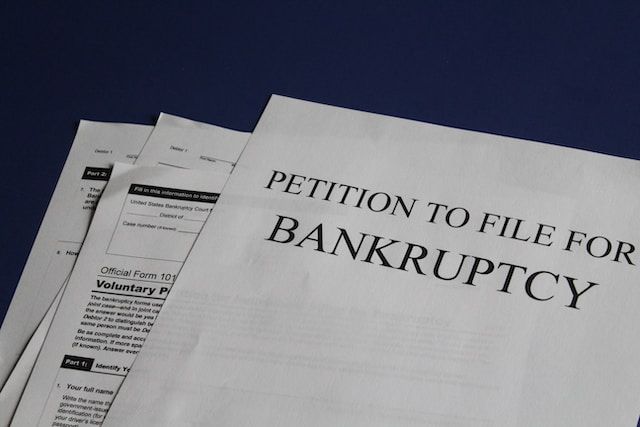What is CVL – a comprehensive guide into the helping hand a business may need

In the complex world of business, not every venture follows the path to success. Some companies, despite the most strategic planning, find themselves in untenable financial positions. When a company becomes insolvent and cannot meet its financial obligations, one of the options available is a process known as Creditors’ Voluntary Liquidation (CVL). This procedure allows an insolvent company to be liquidated in a way that is fair to its creditors, thereby bringing the business to a close and distributing its assets in a manner that follows legal precedence.
Table of Contents
1. What is a CVL – brief definition about the term

Creditors’ Voluntary Liquidation begins when the directors of a company realize that the business can no longer go on due to its liabilities, outweighing its assets, and it cannot meet its debts as they fall due. Unlike compulsory liquidation, which is enforced by court order, typically following a creditor’s petition, CVL is initiated by the company’s directors. They choose to voluntarily bring the business to an end, liquidate the assets, and distribute the proceeds to creditors.
The decision to enter into a CVL is often seen as a more responsible approach to insolvency because the directors take proactive steps to address the situation rather than waiting for external enforcement. This process helps prevent the further diminishing of company assets, thereby offering creditors a better chance of recovering a portion of their debts.
2. CVL meaning – each step that this process requires

The journey through a CVL involves several critical steps, and understanding these helps clarify the role and responsibilities of the concerned parties (i.e., the directors, shareholders, liquidator, and creditors).
Decision to liquidate:
The process starts with the company’s directors concluding that the business is insolvent based on cash flow and balance sheet assessments. They must consult with a licensed insolvency practitioner (IP) or a financial advisor knowledgeable in insolvency matters to understand their options and obligations.
Meeting of shareholders:
Following the consultation, the directors call a General Meeting of shareholders to propose the resolution for liquidation. Shareholders vote on the resolution, and for the CVL to proceed, at least 75% (by value of shares) must be in favor.
Appointment of insolvency practitioner:
Upon the shareholders’ approval, an IP is formally appointed to act as the liquidator. The liquidator’s role is crucial as they take control of the company, cease its trading activities, terminate employees, sell the company’s assets, and communicate with creditors.
Creditors’ meeting:
Although modern practice in many jurisdictions has shifted towards electronic communication, traditionally, a creditors’ meeting would be held. The purpose is to allow creditors to be informed of the reasons behind the company’s demise, ask questions, and even propose a different liquidator if they believe it’s in their best interests.
Realization of assets:
The liquidator assumes the responsibility of turning assets into cash (liquidation). This step might involve selling property, inventory, intellectual property, and other assets of value. The primary purpose is to generate funds to distribute to creditors and cover the liquidation process costs.
Settlement of claims and dissolution:
After asset liquidation, the proceeds are used to pay the costs of the liquidation and outstanding claims, following the legal priority of debts. Finally, the company is formally dissolved, marking its legal end as a corporate entity.
Implications for involved parties:
The CVL process impacts various stakeholders, including directors, employees, shareholders, and creditors.
Directors: Directors are obligated to act in the creditors’ best interests from the moment they realize the company is insolvent. Failure to do so or to engage in wrongful or fraudulent trading can lead to personal liabilities and legal consequences, including disqualification from serving as a director in the future. Moreover, they should understand the Creditors Voluntary Liquidation process and respect each step.
Employees: Unfortunately, employees are often made redundant, a fact that is often considered a Creditors’ Voluntary Liquidation disadvantage. They become creditors for their unpaid wages and redundancy pay and can claim from the government’s national insurance fund, depending on the jurisdiction.
Shareholders: Shareholders are the last to be paid in a liquidation scenario, and in most CVL cases, they receive no return on investment as the company’s assets are usually insufficient to cover its debts.
Creditors: Creditors are central to the CVL process. They’re entitled to a fair distribution of the available proceeds from the liquidated assets. However, they must file proof of their claims to the liquidator, and the settlement follows a statutory order of priority.
So, Creditors’ Voluntary Liquidation represents an orderly, fair, and transparent method of dealing with corporate insolvency. It underscores the importance of directorial responsibility and creditor rights during financial distress. While it signifies the end of a business venture, it also reflects the practicalities of commercial risk and the importance of ethical management in the face of financial adversity. It’s a stark reminder for directors to keep constant vigilance over their company’s financial health and act proactively if they suspect insolvency and understand what CVL means, thus safeguarding the interests of creditors and reinforcing healthy business practices.
2.1. Creditors’ Voluntary Liquidation process – how long does this process take?
When a company becomes insolvent, one of the structured approaches for winding up its affairs is understanding what is a Creditors' Voluntary Liquidation procedure. This pathway, while providing a systematic process for closing a business, involves several stages that can vary significantly in duration. Understanding the timeline helps stakeholders set realistic expectations and prepare accordingly.
Creditors' Voluntary Liquidation occurs when the directors of a company decide—after realizing that their business is insolvent and cannot continue due to its debts—to voluntarily wind it up. The Creditors’ Voluntary Liquidation advantage is that it is designed to distribute the company's assets fairly among creditors, ceasing operations in a manner that is compliant with legal requirements. Although this route signifies the end of the business, it is often seen as a conscientious approach because it prevents further financial loss for creditors by halting trading and commencing asset liquidation.
The CVL process is not instantaneous and can often take longer than expected. The exact timeline varies depending on several factors:
-
Size and complexity of the company:
Larger companies with numerous assets, creditors, and complex corporate structures require a more intricate liquidation process and thus, a larger Creditors’ Voluntary Liquidation cost. Identifying, valuing, and selling assets in such situations can be time-consuming, particularly if the assets are specialized or market conditions are unfavorable.
-
Efficiency of record keeping:
A company's record-keeping efficacy significantly impacts the liquidation duration. If financial records, asset documentation, and creditor information are well-organized and readily accessible, the process is streamlined. Conversely, poor record-keeping practices can lead to substantial delays as the appointed insolvency practitioner (IP) spends time gathering necessary data.
-
Legal considerations and disputes:
Occasionally, legal issues such as creditor disputes, contract complexities, or ongoing litigation can arise, stalling the liquidation process. The liquidator must address these issues before assets can be distributed, ensuring adherence to legal protocols and fairness principles.
-
The liquidator’s role:
The speed at which the liquidator can operate is also crucial. This pace is determined by their efficiency, experience, and workload. Furthermore, a liquidator must conduct a thorough investigation into the company’s affairs, including the reasons for its failure, which can be time-intensive depending on the circumstances encountered.
-
Asset realization:
The nature of the company's assets affects the length of the CVL. Liquid assets or those that are easily sold will expedite the process. In contrast, non-liquid assets, like real estate or unquoted shares, usually require a longer period to dispose of at an appropriate value.
The duration of a Creditors' Voluntary Liquidation process is influenced by multiple factors, ranging from the company's size to asset nature, and legal challenges faced during liquidation. While it’s beneficial for directors to initiate the CVL process early in the face of insolvency, understanding that the timeline is rarely short is important for setting realistic expectations. This comprehensive winding-up mechanism, despite its length, ensures the fair and legal distribution of assets, preserving the integrity of business dealings in the harsh landscape of corporate insolvency. Stakeholders involved in a CVL should employ patience and detailed attention to their respective roles, aiding a smoother, more efficient liquidation process.
2.2. Creditors’ Voluntary Liquidation cost – the cost you should consider

While the CVL process is a structured and responsible approach to winding up a company, it comes with various costs that stakeholders often need to understand to make informed decisions.
Initiating a CVL involves several parties, procedures, and legal protocols, all of which influence how much a CVL costs. The expenses typically associated with a CVL can be broadly categorized into the following segments:
Insolvency Practitioner’s (IP) fees:
The most significant cost in a CVL process is usually the remuneration of the insolvency practitioner, who plays a pivotal role in carrying out the liquidation. IPs charge for their professional services, and these fees can vary widely based on the practitioner’s experience, reputation, and geographical location.
The complexity of the work involved also impacts the IP’s fees. For instance, a company with substantial assets, numerous creditors, or complex financial arrangements would require a more labor-intensive liquidation process, increasing the IP’s workload and, consequently, their fees.
Legal costs:
The liquidation process may necessitate various legal procedures, including the drafting of legal notices, potential litigation, dealing with creditor claims, and the legal aspects of selling the company’s assets. These necessities require legal expertise, contributing to the overall cost of the CVL.
Statutory advertising:
Companies undergoing a CVL are required by law to advertise their liquidation in certain jurisdictions, such as in The Gazette in the United Kingdom. These statutory notices, including those for creditor meetings or final meetings marking the dissolution of the company, involve costs that add to the total expense of the liquidation process.
Asset realization costs:
Selling the company’s assets, a fundamental part of the liquidation process, involves costs. These can include professional valuations, broker fees, auction costs, or charges related to the secure storage and transportation of physical assets before sale. The type and value of the assets in question would influence these costs.
Meeting and administration expenses:
There are administrative costs involved in winding up a company. These include organizing meetings with creditors, sending out statutory communications or reports, and other general administrative expenses. While these might seem minor compared to other costs, they add up and form a part of the overall financial burden of the process.
Factors influencing the total cost:
The total CVL cost can be influenced by several factors, some of which have been hinted at in the breakdown above. Here’s a more detailed look at these variables:
Company size and complexity: Larger companies with intricate corporate structures and numerous assets and creditors naturally face higher liquidation costs. There’s more work involved in valuing and selling assets, contacting creditors, and fulfilling statutory obligations for larger entities.
Asset value: The total value of a company’s assets is a crucial factor. Higher-value assets might reduce liquidation costs in relative terms, as the sale proceeds could cover a larger portion of the expenses. Conversely, companies with negligible assets might struggle to cover the liquidation costs, potentially requiring directors or shareholders to cover the shortfall.
Number of creditors: A company with many creditors will incur higher costs due to the increased complexity in communicating with these parties, addressing their claims, and distributing the proceeds from asset sales.
Disputes and legal complications: If the CVL process encounters legal hurdles, such as disputes over asset ownership or creditor claims, the resulting legal fees will add to the total cost.
Choice of Insolvency Practitioner: IPs’ fees can vary substantially. While it might be tempting to go for a cheaper option, it’s vital to ensure that the appointed IP is reputable, experienced, and thorough, as this professionalism can prevent further complications and additional costs down the line.
Realistic financial expectations: Given the variables involved, providing a certain value of how much is a CVL is hard. However, stakeholders can anticipate costs ranging from a few thousand to tens of thousands of dollars, pounds, or the relevant currency. It’s essential for company directors to obtain detailed, itemized quotes from IPs before commencing the process, allowing for a clearer understanding of the impending costs.
A Creditors’ Voluntary Liquidation, while a sensible course of action for insolvent companies, is not without significant costs. These expenses, spanning professional fees to administrative charges, contribute to the financial gravity of the decision to enter liquidation. For company directors and shareholders, understanding these costs is essential, ensuring transparency and preparedness in navigating the end of a business’s lifecycle. Given the variability, seeking quotations from multiple insolvency practitioners, and possibly negotiating terms, could provide some financial relief in this challenging period, ensuring the company fulfills its legal obligations without unnecessary financial strain.
3. Creditors’ Voluntary Liquidation – advantages and disadvantages that a business may take into account

Now that you’ve understood what this process means and what costs it may require, it is the proper time for you to discover the Creditors’ Voluntary Liquidation advantages and disadvantages.
Creditors’ Voluntary Liquidation advantages:
Controlled and structured closure:
One of the primary advantages of a CVL is the structured manner in which the company is wound up. This formal process allows for an orderly dissolution, avoiding the chaos that can often accompany bankruptcy or compulsory liquidation. It provides a sense of control to the directors, as they’re the ones initiating the process, allowing them to potentially influence the choice of liquidator and the timing of the liquidation.
Potential protection from wrongful trading accusations:
When directors continue to trade while the company is insolvent, they risk accusations of wrongful trading, which could lead to personal liability for business debts. By opting for a CVL, directors demonstrate a responsible attitude, choosing to cease trading to prevent further losses to creditors. This action can protect directors from potential legal consequences, showcasing their commitment to fulfilling their duties even in challenging times.
Creditor relationships:
Entering into a CVL can preserve the dignity of the business in the eyes of its creditors. Instead of leaving creditors to initiate legal action, the company itself acknowledges its financial position and takes proactive steps to resolve it. This decision can maintain a more positive relationship with creditors, as assets are distributed in a legally compliant manner, often ensuring that creditors receive a better return than they would in a forced liquidation scenario.
Emotional relief and a fresh start:
Continuing to operate an insolvent company can be a significant emotional burden for the directors, filled with stress and uncertainty. Choosing a CVL allows for closure and the potential for a fresh start. While it’s the end of the current business, it opens up new avenues for the future, free from the weight of unsustainable debt.
Creditors’ Voluntary Liquidation disadvantages:
Finality and loss of business:
Undoubtedly, the most glaring disadvantage of a CVL is the end of the business. Liquidation means the company ceases to exist, with all its operations ending. This outcome leads to job losses for employees and the loss of the products or services the business offered. For directors, especially those who’ve built the company from the ground up, this finality can be particularly distressing.
Potential for director scrutiny:
While a CVL protects directors from accusations of wrongful trading, it opens them up for scrutiny. The insolvency practitioner appointed will conduct an investigation into the company’s downfall, including the directors’ role in the demise. If any misconduct or negligence is uncovered, directors could face disqualification, personal liability, or other legal ramifications.
Financial cost:
The CVL process is not free. There are costs involved, including the insolvency practitioner’s fees, legal costs, and other administrative expenses. These costs can be a burden, especially considering the company is already in financial distress. In some instances, directors or shareholders may need to cover some of these expenses personally if the business’s assets are insufficient.
Impact on credit and reputation:
Having a company enter liquidation can impact the personal credit rating of the directors, especially if they’ve provided personal guarantees for business debts. Furthermore, the reputation of the directors can be affected, making it challenging to start another venture or occupy directorial positions in other companies, as stakeholders may be wary of their history.
Weighing the decision:
Given these pros and cons, deciding on a CVL is not straightforward. It’s a path that offers dignity in insolvency, potentially protecting directors legally and offering a structured end to the business. However, it comes with costs, scrutiny, and the undeniable consequence of ending the company. This decision requires careful consideration, legal counsel, and usually, the guidance of a financial advisor or insolvency practitioner.
Directors should consider all the available options and the specific circumstances surrounding their business’s financial troubles. Alternatives could include negotiating agreements with creditors, restructuring the business, or seeking new forms of investment. These routes could potentially save the company from liquidation, preserving the livelihoods of employees and the directors’ hard work.
To conclude, Creditors’ Voluntary Liquidation is a complex process, offering both relief and consequences. For directors facing the daunting prospect of insolvency, understanding these aspects ensures a more informed decision-making process. While the CVL route can signify the end of an era, it also highlights the importance of responsible financial management, adherence to legal obligations, and sometimes, the courage to start anew. In some cases, this finale can be the most honorable option, serving the best interests of all involved parties and marking the start of a new chapter for the directors.